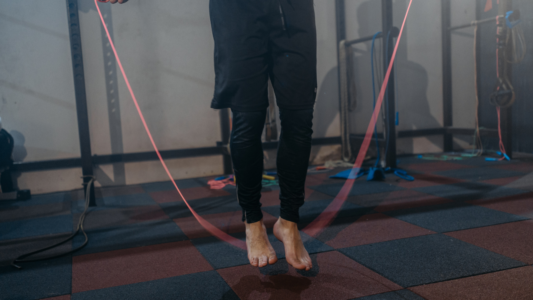
Benefits of Jumping Rope
Jumping rope is a fantastic exercise that delivers a ton of benefits. Many people wrongly believe that jumping rope is an exercise reserved for school age girls, or conversely, that it’s much to difficult and strenuous to employ in their fitness routine. However, with the right approach, jumping rope can help just about anyone improve their fitness and coordination. In this article, we will discuss why you should consider adding a jump rope routine into your workout program.
Portable
Jumping rope is an extremely portable and accessible fitness activity. If you are traveling on business or vacation, you can easily pack away your jump rope so that you can continue to work out on vacation.
Affordable
Unlike a weight set, elliptical or treadmill, a jump rope is also an extremely affordable piece of fitness equipment. Most jump ropes cost between $5 and $10 and will usually last a couple years. You do not need to drop serious cash to start a jump rope routine.
Scalable
Beginners can start with just 30 seconds of jump rope at a time. You can start with small doses of jump rope and increase your time, intensity and speed as you gain fitness, agility and coordination.
Burn Mega Calories
Jumping rope burns tons of calories in a short amount of time, meaning you do not need to jump rope for long to torch serious calories. Just ten minutes of jump rope can burn 100 calories or more, depending on your weight, speed and intensity.
Build Cardiovascular Fitness
Additionally, jumping rope builds amazing cardiovascular fitness. In fact, ten minutes of jumping rope may provide the same cardiovascular benefits of a thirty minute jog. You can easily build amazing cardio fitness with just five to ten minutes per day of jumping rope. Jumping rope is a vigorous cardiovascular activity. The American Heart Association recommends just 75 minutes per week of vigorous cardiovascular activity for overall health. You can meet the total with just ten to fifteen minutes of jump rope per day!
Variety
There are tons of different types of jumps you can learn to perform with your jump rope, allowing for greater workout variety. Additionally, you can customize your jump rope routine for nearly any fitness goal. Longer stretches at slower paces can help you build endurance and stamina. In contrast, performing sprint jump rope intervals can help you improve your VO2 max and anaerobic capacity. Finally, performing more complex or dynamic jumps with the rope can help you develop power, coordination and speed.
Easy on Joints
Contrary to popular belief, jumping rope is actually pretty easy on your joints. Jumping rope is usually easier on your joints than running because you jump and land on two feet instead of one at a time. Learning to jump rope efficiently and with proper technique can also help you reduce the load on your joints with this popular fitness activity.
Build Coordination and Speed
Have you ever seen videos of famous boxers practicing advanced footwork while jumping rope? Many of the best boxers developed coordination, speed and agility with popular jump rope exercises. Performing these movements while fatigued also helped translate to speed and agility during the last rounds of a fatiguing boxing match.
While you may never become the next Mike Tyson, you too can develop coordination and speed with a jump rope routine that incorporates different jumps, fancy footwork, intervals and speed training.
Improves Balance
Did you know that jumping rope actually helps to improve balance? Each jump requires you to balance on the balls of your feet. For this reason, jumping rope is actually a great activity for masters athletes and seniors who wish to regain balance and coordination while improving their cardiovascular fitness.
Fun
Unlike drudging away on a treadmill, jumping rope is just plain fun. Once you build up your jump rope skills and endurance, you may also enjoy this centuries old pastime more than you ever thought possible.
Build Bone Density
Jumping rope is a high impact, weight bearing plyometric activity. This kind of activity stimulates bone formation, especially in the femurs and skeleton. While weight training also builds strong bones, you also need some type of high impact activity like plyometrics, jump rope, Olympic weightlifting or bounding to maximize new bone formation and prevent future bone loss. While building strong bones is important for everyone, it’s especially important for women, particularly women who have a petite bone structure.
Final Thoughts
Jumping rope is a fantastic exercise that can suit just about anyone.
What do you think? Do you jump rope regularly or have you benefitted from this fitness activity? Please let me know in the comment section below.
Need help incorporating jump rope training into your workout routine? Consider applying for personal training or online coaching.